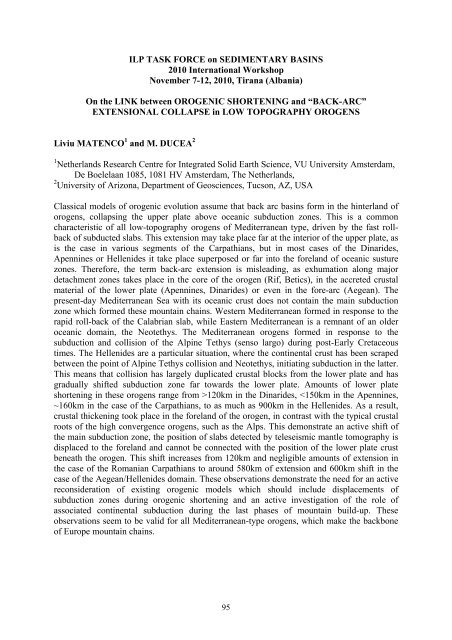DYNAMICS and ACTIVE PROCESSES - International Lithosphere ...
DYNAMICS and ACTIVE PROCESSES - International Lithosphere ...
DYNAMICS and ACTIVE PROCESSES - International Lithosphere ...
You also want an ePaper? Increase the reach of your titles
YUMPU automatically turns print PDFs into web optimized ePapers that Google loves.
ILP TASK FORCE on SEDIMENTARY BASINS<br />
2010 <strong>International</strong> Workshop<br />
November 7-12, 2010, Tirana (Albania)<br />
On the LINK between OROGENIC SHORTENING <strong>and</strong> “BACK-ARC”<br />
EXTENSIONAL COLLAPSE in LOW TOPOGRAPHY OROGENS<br />
Liviu MATENCO 1 <strong>and</strong> M. DUCEA 2<br />
1 Netherl<strong>and</strong>s Research Centre for Integrated Solid Earth Science, VU University Amsterdam,<br />
De Boelelaan 1085, 1081 HV Amsterdam, The Netherl<strong>and</strong>s,<br />
2 University of Arizona, Department of Geosciences, Tucson, AZ, USA<br />
Classical models of orogenic evolution assume that back arc basins form in the hinterl<strong>and</strong> of<br />
orogens, collapsing the upper plate above oceanic subduction zones. This is a common<br />
characteristic of all low-topography orogens of Mediterranean type, driven by the fast rollback<br />
of subducted slabs. This extension may take place far at the interior of the upper plate, as<br />
is the case in various segments of the Carpathians, but in most cases of the Dinarides,<br />
Apennines or Hellenides it take place superposed or far into the forel<strong>and</strong> of oceanic susture<br />
zones. Therefore, the term back-arc extension is misleading, as exhumation along major<br />
detachment zones takes place in the core of the orogen (Rif, Betics), in the accreted crustal<br />
material of the lower plate (Apennines, Dinarides) or even in the fore-arc (Aegean). The<br />
present-day Mediterranean Sea with its oceanic crust does not contain the main subduction<br />
zone which formed these mountain chains. Western Mediterranean formed in response to the<br />
rapid roll-back of the Calabrian slab, while Eastern Mediterranean is a remnant of an older<br />
oceanic domain, the Neotethys. The Mediterranean orogens formed in response to the<br />
subduction <strong>and</strong> collision of the Alpine Tethys (senso largo) during post-Early Cretaceous<br />
times. The Hellenides are a particular situation, where the continental crust has been scraped<br />
between the point of Alpine Tethys collision <strong>and</strong> Neotethys, initiating subduction in the latter.<br />
This means that collision has largely duplicated crustal blocks from the lower plate <strong>and</strong> has<br />
gradually shifted subduction zone far towards the lower plate. Amounts of lower plate<br />
shortening in these orogens range from >120km in the Dinarides,




